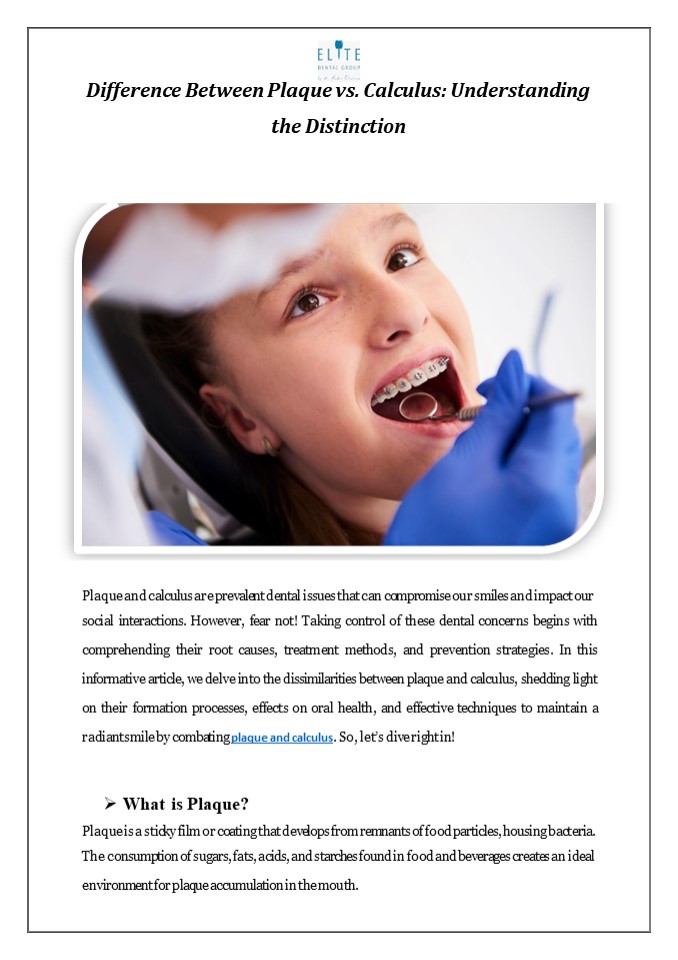Difference Between Plaque vs. Calculus: Understanding the Distinction - PowerPoint PPT Presentation
Title:
Difference Between Plaque vs. Calculus: Understanding the Distinction
Description:
Plaque and calculus are prevalent dental issues that can compromise our smiles and impact our social interactions. However, fear not! Taking control of these dental concerns begins with comprehending their root causes, treatment methods, and prevention strategies. In this informative article, we delve into the dissimilarities between plaque and calculus, shedding light on their formation processes, effects on oral health, and effective techniques to maintain a radiant smile by combating plaque and calculus. So, let’s dive right in! Visit: – PowerPoint PPT presentation
Number of Views:2
Title: Difference Between Plaque vs. Calculus: Understanding the Distinction
1
Difference Between Plaque vs. Calculus
Understanding the Distinction
Plaque and calculus are prevalent dental issues
that can compromise our smiles and impact
our social interactions. However, fear not!
Taking control of these dental concerns begins
with comprehending their root causes, treatment
methods, and prevention strategies. In this
informative article, we delve into the
dissimilarities between plaque and calculus,
shedding light on their formation processes,
effects on oral health, and effective techniques
to maintain a radiant smile by combating plaque
and calculus. So, lets dive right in!
- What is Plaque?
- Plaque is a sticky film or coating that develops
from remnants of food particles, housing
bacteria. - The consumption of sugars, fats, acids, and
starches found in food and beverages creates an
ideal environment for plaque accumulation in the
mouth.
2
Initially colorless and inconspicuous, dental
plaque can lead to tooth discoloration and a
fuzzy sensation on the tooth surface when left
untreated. Dental complications associated with
plaque include cavities, gingivitis (gum
disease), abscessed teeth, and tooth loss.
Although small plaque buildups within a few hours
may not raise immediate concern, neglecting to
brush teeth after meals leads to rapid
accumulation, harboring bacteria that contribute
to tooth decay, gum disease, and other oral
health issues.
- What is Calculus?
- Often referred to as tartar in dental
terminology, calculus is a hardened form of
dental plaque. - Calculus forms when plaque attracts deposits of
calcium and other minerals from saliva and food
particles, resulting in solidification. Over
time, calculus accumulation worsens oral health
and is often accompanied by halitosis (bad
breath), which can cause embarrassment and social
discomfort. Complications associated with dental
calculus include halitosis, periodontitis (a
severe form of gum disease), receding gums, and
tooth decay. Left untreated, calculus poses
challenges in effective teeth cleaning and
contributes to tooth decay and other oral
infections.
- Key Differences between Plaque and Calculus
- Plaque and calculus differ significantly in
composition, removal methods, and dental - consequences. The following table highlights the
disparities between plaque and calculus
3
Plaque Calculus
Soft and sticky film formed on teeth Hardened and calcified plaque
Composed of bacteria and food particles Contains mineral deposits, bacteria, and plaque
Can be removed by regular brushing and flossing Cannot be removed by brushing and flossing alone
Develops within hours after eating Forms from an accumulation of untreated plaque
Results in tooth decay, gum disease, and bad breath Leads to gum inflammation, gum disease, and oral infections
Controlled and prevented through proper oral hygiene Requires professional dental cleaning for effective removal
The most effective approach for combating
calculus is professional dental cleaning. You
can prevent calculus formation by maintaining
regular teeth brushing and proper flossing
routines. Understanding the dissimilarities
between plaque and calculus empowers you to take
the necessary steps in addressing these dental
issues.
Preventing Dental Plaque and Calculus Buildup
- Here are some practical tips to prevent the
buildup of plaque and calculus - Floss once daily using clinically approved dental
floss. - Brush teeth with a soft-bristled toothbrush and
fluoride toothpaste. - Avoid sugary foods and chewing gum.
- Choose healthy foods such as plain yogurt,
cheese, raw vegetables, or fruits. - Schedule dental checkups at least twice a year.
4
- Seek professional dental cleaning during checkups
to remove plaque and tartar. - Consider dental sealants to prevent plaque
formation on the chewing surface. - Use fluoride toothpaste to inhibit the growth of
plaque-causing microorganisms and reduce the
risk of oral complications.
In conclusion, maintaining excellent oral health
is essential for a beautiful smile and overall
well- being. Begin incorporating simple
interventions such as brushing after meals and
daily flossing into your routine. Additionally,
booking regular dental checkups at least twice a
year is a practical approach to prevent plaque
and calculus. During these checkups, a
professional dentist will examine your teeth and
provide personalized recommendations for
maintaining optimal oral health.
For More Information Please Visit Our
Website https//elitedentalg.com/

